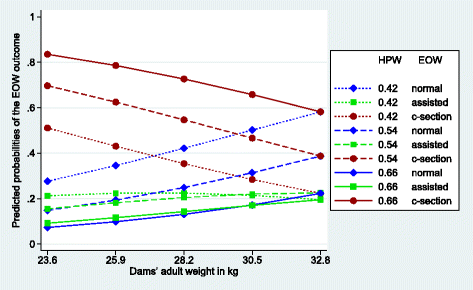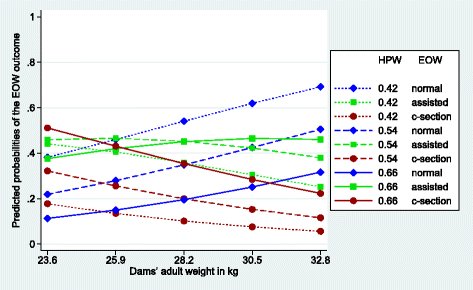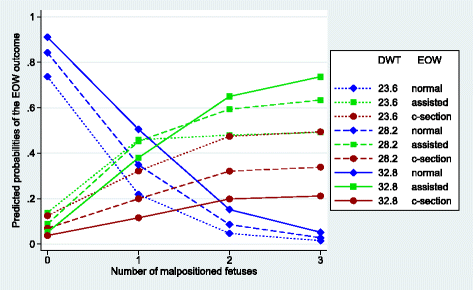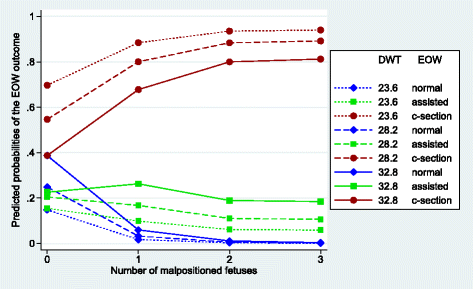Factors contributing to the decision to perform a cesarean section in Labrador retrievers
- PMID: 29482570
- PMCID: PMC5828337
- DOI: 10.1186/s12917-018-1381-8
Factors contributing to the decision to perform a cesarean section in Labrador retrievers
Abstract
Background: In the past 10 years, the frequency of unplanned cesarean sections in the Labrador Retriever breeding colony at Guiding Eyes for the Blind stayed around 10% (range 5% to 28%). To reduce the number of cesarean sections, factors influencing the occurrence of a cesarean section need to be known. The goal of this study was to identify factors that contribute to the decision to perform a cesarean section.
Results: Of the 688 Labrador Retriever litters whelped between 2003 and 2016, 667 litters had sufficient data and remained in the analysis. The target trait was ordinal with the three levels "normal whelping", "assisted whelping" and "cesarean section". A general ordinal logistic regression approach was used to analyze the data. Model selection with possible predictors resulted in a final model including weight of the dam, the weight of the heaviest puppy of a litter, the number of fetuses malpositioned and the quality of uterine contractions. Weight and size of a litter, parity, maternal inbreeding coefficient, whelping season, dam and sire were dropped from the model because they were not significant. The risk of a cesarean section was influenced by the combination of the weight of the dam and the weight of the heaviest puppy in the litter, as well as by the number of malpositioned fetuses and the quality of the contractions. Larger puppies increased the risk of cesarean section especially when the dam had a lighter weight. For dams weighing 23.6 kg and 32.8 kg the predicted probability of a cesarean section was low, with 0.06 and 0.02, respectively, when the heaviest puppy in a litter was light (0.42 kg), contractions were normal and no fetus was malpositioned. However, the probability of a cesarean section was much higher, ranging from 0.24 to 0.08, when the heaviest puppy in a litter was heavy (0.66 kg).
Conclusions: Means to reduce the cesarean section frequency in this Labrador Retriever breeding colony should include genetic selection for ideal puppy weight. In addition, dams with an adult body weight substantially below average should not be selected as breeders in this colony.
Keywords: Assisted delivery; Cesarean section; Labrador retriever; Risk factors.
Conflict of interest statement
Ethics approval
Not applicable.
Consent for publication
Not applicable.
Competing interests
The authors declare that they have no competing interests.
Publisher’s Note
Springer Nature remains neutral with regard to jurisdictional claims in published maps and institutional affiliations.
Figures






References
-
- Davidson A. Problems during and after parturition. In: England GCW, von Heimendahl A, editors. BSAVA manual of canine and feline reproduction and neonatology. Gloucester: BSAVA; 2010. pp. 121–134.
-
- Evans KM, Adams VJ. Proportion of litters of purebred dogs born by cesarean section. JSAP. 2010;51:113–118. - PubMed
MeSH terms
LinkOut - more resources
Full Text Sources
Other Literature Sources
Medical
Miscellaneous

